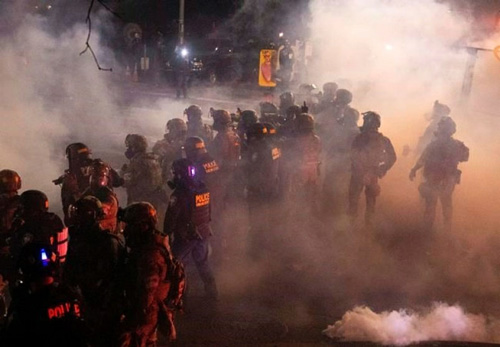Portland, Ore.
Thousands of protesters gathered outside the federal courthouse in Portland, Oregon, into the early hours Saturday, shooting fireworks at the building as plumes of tear gas dispensed by U.S. agents, lingered above.
The demonstration went until federal agents entered the crowd around 2:30 a.m. and marched in a line down the street, clearing remaining protesters with tear gas at close range. They also extinguished a large fire in the street outside the courthouse.
Portland has been roiled by nightly protests for two months following the killing of George Floyd in Minneapolis. President Donald Trump said he sent federal agents to Oregon’s largest city to halt the unrest but state and local officials say they are making the situation worse.
The clashes in Portland have further inflamed the nation’s political tensions and triggered a crisis over the limits of federal power as Trump moves to send U.S. officers to other Democratic-led cities he says are violent.
Late Friday a federal judge denied a request by Oregon’s attorney general to restrict the actions of federal police.
The Federal Protective Service had declared the gathering in Portland that began Friday evening as “an unlawful assembly” and said that officers had been injured.
As the crowd dispersed, someone was found stabbed nearby, Portland police said. The person was taken to a hospital and a suspect was taken into custody.
By 3 a.m., most demonstrators had left, with only some small groups roaming the streets.
Earlier Friday night, the protest had drawn various organized groups, including Healthcare Workers Protest, Teachers against Tyrants, Lawyers for Black Lives and the “Wall of Moms.” As the crowd grew — authorities estimate there were 3,000 present at the peak of the protest — people were heard chanting “Black Lives Matter” and “Feds go home” to the sound of drums.
Later, protesters vigorously shook the fence surrounding the courthouse, shot fireworks towards the building and threw glass bottles. Many times these actions were met by federal agents using tear gas and flash bangs.
The flow of tear gas caused protesters to disperse at times, as others remained toward the front of the courthouse with leaf blowers directing the gas back to the courthouse. Federal agents had leaf blowers of their own to counteract.
Daniel Pereyo was one protester who was tear-gassed. Pereyo said he had been at the nearby park watching drummers and fireworks being shot, when his face and eyes began to burn.
“It’s extremely painful,” he said. “It’s not the worst pain ever, but it is discomforting and it’s distracting.”
As the clouds of gas floated down the street, protesters would swiftly regroup and return to chant and shake the fence that separates the people on the street from federal agents and the courthouse.
It was unclear whether anyone was arrested during the protest. The federal agents have arrested dozens during nightly demonstrations against racial injustice that often turn violent.
The state attorney general sued, saying some people had been whisked off the streets in unmarked vehicles. U.S. District Judge Michael Mosman ruled Friday the state lacked standing to sue on behalf of protesters because the lawsuit was a “highly unusual one with a particular set of rules.”
Oregon was seeking a restraining order on behalf of its residents not for injuries that had already happened but to prevent injuries by federal officers in the future. That combination makes the standard for granting such a motion very narrow, and the state did not prove it had standing in the case, Mosman wrote.
Legal experts who reviewed the case before the decision warned that the judge could reject it on those grounds. A lawsuit from a person accusing federal agents of violating their rights to free speech or against unconstitutional search and seizure would have a much higher chance of success, Michael Dorf, a constitutional law professor at Cornell University, said ahead of the ruling.
“The federal government acted in violation of those individuals’ rights and probably acted in violation of the Constitution in the sense of exercising powers that are reserved to the states, but just because the federal government acts in ways that overstep its authority doesn’t mean the state has an injury,” he said.—AP










